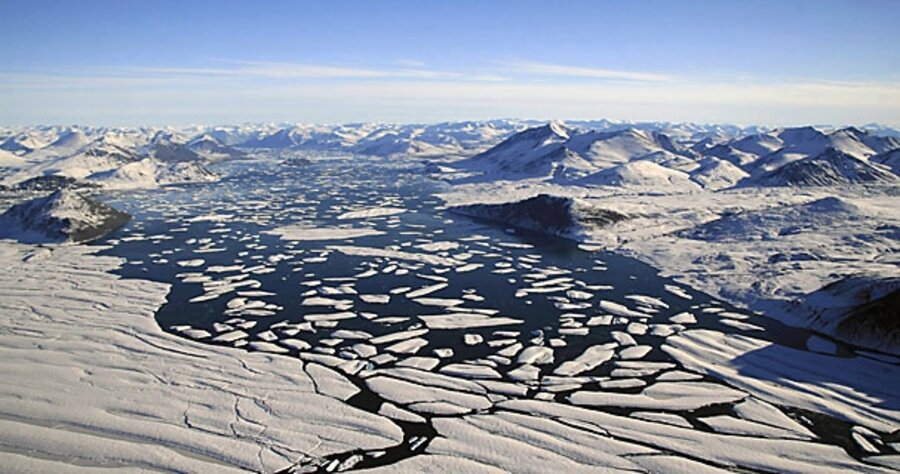Shrinking Arctic Ocean sea ice signals climate change
Loading...
Key portions of Earth’s cryosphere are in deep trouble. So far this summer, Arctic Ocean sea ice has shrunk to its second-lowest extent on record as ice shelves along Canada’s northernmost islands are disintegrating at a rapid pace. A new report from the United Nations Environment Program and the World Glacier Monitoring Service notes that the melt rate for glaciers the service uses as reference sites appears to have doubled since 2000. The resulting increase in open water is expected to have a wide-ranging impact on global warming.
“These are huge areas that are changing,” says Luke Copland, who heads the Laboratory for Cryospheric Research at the University of Ottawa, referring to the ice declines in the Arctic.
People can debate the causes behind what’s happening in the Arctic, he says, “but what we can’t debate is the fact that things are changing, and they’re changing really fast.” Moreover, the changes are irreversible under today’s climate regime, adds Derek Mueller, a polar scientist at Trent University in Peterborough, Ontario.
On Tuesday, Dr. Mueller and his colleagues reported that in early August, the 19-square-mile Markham Ice Shelf broke free of its moorings on the northern coast of Ellesmere Island. It’s now an ice island nearly the size of Manhattan floating freely in the Arctic Ocean.
Another of Canada’s four remaining ice shelves has lost 60 percent of its extent, while a third shelf continues to disintegrate. The accumulated loss for the summer amounts to an area of ice more than three times the size of Manhattan, or some 23 percent of the area that existed heading into summer.
As of Aug. 26, the total seasonal loss of Arctic Ocean sea ice was slightly more than 2 million square miles. That’s 760,000 square miles below the 1979-2000 average, according to the National Snow and Ice Data Center in Boulder, Colo.
The loss of the shelves will snuff out unique microbial ecosystems that have helped biologists gauge the range of extreme environments in which life can take hold, the researchers say. In addition, as free-floating islands, the shelves endanger offshore oil and gas exploration efforts. Drilling platforms were never designed to endure the impact of a 130-foot-thick, city-sized patch of ice.
Researchers say global warming has directly contributed to the loss as air and ocean temperatures have warmed. Indirectly, climate change appears to influence a naturally varying climatic feature known as the Arctic Oscillation.
There is some evidence suggesting that global warming has pushed the Arctic Oscillation into its amped-up phase more frequently over the past 20 to 30 years, notes Ignatius Rigor, a specialist on Arctic climate and sea ice at the University of Washington’s Polar Science Center in Seattle. One effect of that phase is to generate winds that drive sea ice out of the Arctic Ocean and into the North Atlantic. Dr. Rigor notes that in the late 1980s and early ’90s, a shift in the Arctic Oscillation “flushed a lot of sea ice out,” setting summer sea ice on its long-term trajectory of decline.
That loss then feeds into the reduction of the ice shelves, Dr. Copland adds. The shelves – the oldest sea ice in the Arctic – developed over thousands of years as the deep cold of winter froze more water than the shelves lost during the summer. Snowfall also contributed to the thickness.
But average annual air temperatures around Ellesmere Island have warmed by about 2 degrees C (3.6 degrees F) over the past 50 years. That average masks wintertime temperatures that have risen an estimated 5 degrees C, says Copland. The return of ice during winters has failed to compensate for the ice lost during warmer summers. As sea ice retreats, the shelves become vulnerable to rolling swells coming off open water. The shelves “just vibrate themselves to pieces,” he adds.
Until now, the loss of Arctic ice has had far less effect on large-scale ocean circulation patterns than researchers once expected, Rigor says. But increasing amounts of open water in the Arctic absorb heat, which forestalls the onset of the fall and winter freeze.
The influence of that warming could have geographically far-reaching effects. In June, scientists with the National Center for Atmospheric Research in Boulder, Colo., and the Snow and Ice Data Center calculated that during five- to 10-year periods of rapid sea-ice loss, autumn temperatures could rise by up to 9 degrees F along the coastlines that ring the Arctic Ocean. That warming would prolong the melt season for permafrost, increasing the rate at which it releases enormous amounts of stored carbon as greenhouse gases carbon dioxide or methane.
“We’ve had three or four record minimums in the last decade,” Rigor says of lost sea ice. The way things are going, “it will be tough for the summer sea ice to recover.”
[Editor's note: The original version of this story incorrectly stated that summertime temperatures around Ellesmere Island had increased 5 degrees C.]





